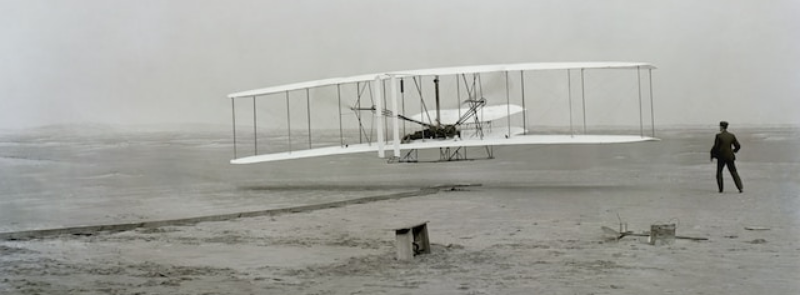
When It Occurs
Every December 17th
Official Website
Timeline
Days Passed (743)
# Hashtags
#WrightBrothersDay #GiveMeWings
December 17 is observed as Wright Brothers Day in the United States each year. This day pays tribute to the first successful flights of a mechanically propelled airplane that was heavier-than-air. Orville and Wilbur Wright, commonly known as the Wright brothers, accomplished this feat in 1903 near Kitty Hawk, North Carolina. An annual proclamation encourages Americans to celebrate the day through various ceremonies and activities.
History
- First Flight: On December 17, 1903, the Wright brothers successfully flew the first powered, controlled, and sustained airplane flight near Kitty Hawk, North Carolina. Orville piloted the first flight, which lasted 12 seconds and covered 120 feet. Wilbur and Orville each made two flights that day, with the longest lasting 59 seconds and covering 852 feet.
- Proclamation: Wright Brothers Day was established by a joint resolution of Congress in 1959. Each year, the President of the United States issues a proclamation recognizing December 17th as Wright Brothers Day to honor their achievements and contributions to aviation.
Significance
Wright Brothers Day holds significant importance for several reasons:
- Historical Achievement: It marks the anniversary of a pivotal moment in aviation history, celebrating the Wright brothers' successful flight and their role as pioneers in aviation.
- Innovation and Inspiration: It highlights the spirit of innovation and determination demonstrated by the Wright brothers, inspiring future generations of engineers, pilots, and innovators.
- Aviation Progress: It acknowledges the advancements in aviation technology and the impact of flight on transportation, commerce, and global connectivity.
Ways to Celebrate
-
Learn About the Wright Brothers:
- Books and Documentaries: Read books or watch documentaries about the Wright brothers, their experiments, and the development of their aircraft.
- Biographies: Explore detailed biographies to understand their lives, challenges, and achievements.
-
Visit Historical Sites:
- Wright Brothers National Memorial: Visit the Wright Brothers National Memorial in Kitty Hawk, North Carolina, where the first flight took place. The site features a visitor center, historical markers, and a monument.
- Dayton, Ohio: Explore sites in Dayton, Ohio, where the Wright brothers lived and worked, including the Wright Cycle Company and the Huffman Prairie Flying Field.
-
Attend Aviation Events:
- Reenactments: Participate in or watch reenactments of the Wright brothers' first flight at historical sites or aviation museums.
- Airshows: Attend airshows or aviation exhibitions that feature historical aircraft, flight demonstrations, and educational programs.
-
Engage in Educational Activities:
- School Programs: Encourage schools to include lessons about the Wright brothers and the history of aviation in their curriculum.
- STEM Activities: Organize or participate in STEM (Science, Technology, Engineering, and Mathematics) activities related to aviation, such as building model airplanes or learning about aerodynamics.
-
Celebrate on Social Media:
- Share Stories: Share stories, photos, and facts about the Wright brothers and their achievements on social media using hashtags like #WrightBrothersDay and #FirstFlight.
- Virtual Tours: Take virtual tours of historical sites and museums related to the Wright brothers and share your experiences online.
-
Support Aviation Education:
- Donations: Donate to organizations that support aviation education, such as the Experimental Aircraft Association (EAA) or local aviation museums.
- Volunteer: Volunteer your time or skills to support aviation education programs, youth aviation clubs, or community events.
Key Achievements of the Wright Brothers
- First Powered Flight: The Wright brothers' flight on December 17, 1903, marked the first time a powered, controlled, and sustained flight was achieved.
- Innovative Design: Their Flyer I aircraft featured a three-axis control system, which allowed the pilot to steer the aircraft and maintain its equilibrium. This design became the standard for fixed-wing aircraft.
- Continued Development: After their first flight, the Wright brothers continued to improve their designs, achieving longer and more controlled flights and contributing to the development of practical aviation.
Fun Facts About the Wright Brothers
- Bicycle Business: Before their aviation experiments, the Wright brothers operated a successful bicycle sales and repair business in Dayton, Ohio.
- Self-Taught Engineers: The Wright brothers were self-taught engineers, learning about flight through their own experiments, observations, and studies of previous aviation pioneers.
- Modest Beginnings: The materials for their first Flyer, including the engine, were constructed in their bicycle shop, showcasing their ingenuity and resourcefulness.
Inspirational Quotes About the Wright Brothers
- "The desire to fly is an idea handed down to us by our ancestors who... looked enviously on the birds soaring freely through space... on the infinite highway of the air." – Wilbur Wright
- "If we worked on the assumption that what is accepted as true really is true, then there would be little hope for advance." – Orville Wright
- "No bird soars too high if he soars with his own wings." – William Blake
Conclusion
Wright Brothers Day is a celebration of the pioneering achievements of Orville and Wilbur Wright, whose successful flight on December 17, 1903, revolutionized aviation. Whether learning about their history, visiting historical sites, attending aviation events, engaging in educational activities, celebrating on social media, or supporting aviation education, there are many ways to honor this day. Wright Brothers Day encourages everyone to appreciate the spirit of innovation and determination that drives progress in aviation and beyond.


